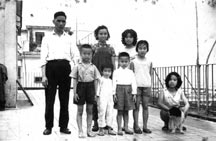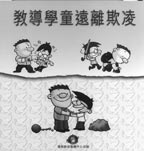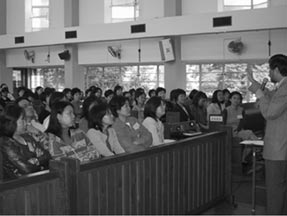In this paper Dennis Sing-Wing Wong, Associate Professor, City University of Hong Kong and Chairman, Centre for Restoration of Human Relationships, Hong Kong, China, discusses his experiences implementing restorative justice with Hong Kong youth in social work, education and the legal system. This paper was presented at the third in a series of three IIRP conferences with the theme, "Building a Global Alliance for Restorative Practices and Family Empowerment," in Penrith, Australia, March 3-5, 2005.
Paper from ''Building a Global Alliance for Restorative Practices and Family Empowerment, Part 3'', the IIRP’s Sixth International Conference on Conferencing, Circles and other Restorative Practices, March 3-5, 2005, Penrith, New South Wales, Australia.
Introduction
|
Over the past ten years, I have been endeavouring to seek answers to the following two questions:
1. Are there ways of holding juvenile offenders accountable to victims, but at the same time leaving offenders a chance to rehabilitate from their wrongdoing, while protecting community safety?
2. If restorative justice[1] is a ‘balanced’ strategy, how can it be implemented, particularly as an alternative to prosecution for juvenile offenders?
Having studied different types of juvenile justice models and practised various kinds of therapeutic methods, I find restorative justice (RJ) an appropriate answer to my first question. I also believe that RJ is a balanced strategy, and that it can be put into practice through various conferencing and mediation techniques.[2] I will not attempt to provide explanations about why I find RJ so powerful now, but you will get the answer after knowing about our recent works more thoroughly.
In this paper I will firstly describe my upbringing and background. This may shed light upon why I am interested in delinquency study and restorative practices. Then, I will share with you efforts that I and my associates are devoted to. At the end, I will discuss with you about the future development of RJ in Hong Kong and China.
Personal History and Interest in RJ
I developed interest in studying and practising RJ when I was very young. In those days, I was nearly at the edge of delinquency and did not do well at school in the period between the mid-1960s and early 1970s.
|
I was born in a working-class family in the late 1950s in Hong Kong, a British colony at that time. My father was a porter and my mother was a cleaning lady at the same building. My parents, one brother, four sisters and I lived in a tiny penthouse on the rooftop of a 12-storey building since I was in kindergarten. While I was studying in a primary school near my abode, I was used to going with classmates up to a hill situated 50 metres from my building and fooling around until dinner time. My classmates were also from working-class families. We all shared a rather similar belief (perhaps an irrational one): ‘Despite how hard we try, working-class boys will not have a bright future anyway’.
When we were 11 to 12, we occasionally shoplifted snacks from a shopkeeper who sold ice cream and snacks from a mobile motorcycle. This motorcycle was always parked outside the front door of our primary school. Furthermore, I was addicted to gambling during the first and second years of secondary school education. My friends and I spoke foul language frequently and sometimes played truant and went out gambling, when we were 13 to 16. Deep down in my heart, I did respect my parents and wanted to keep a good relationship with my family members. Nevertheless, I was rather rebellious at that time and was greatly influenced by peers who also came from frustrated and alienated working-class backgrounds.
|
In China, the experience of engaging in unruly behaviour is an interactive process in which one is torn between two salient Chinese values, ‘filial piety/respecting parents’ and ‘gang brotherhood’. It was not until Form Four of my secondary education (i.e., the first year in high-school education), with the help of a pastor and some Christian brothers and sisters in church, that I became aware of the importance of academic performance and a future career. I then decided to start a new life and stopped gambling or fooling around. Advised by my pastor, I took the lead in restoring relationships with my parents and siblings, then my teachers, and the motorcycle ice-cream shopkeeper. To recover from the guilty feeling of hurting others, I wrote letters of apology to parents and teachers to show repentance. Most important of all, I tried to make reparations to the motorcycle shopkeeper by buying over five ice creams at one time, even though I did not intend on eating them all. By doing so, I felt much better, as if I had repaired the harm done. Interpreting these actions with updated terminology, I am sure that I had adopted restorative practices.
I was also fortunate when I barely passed the Hong Kong Advanced-Level Examination during the seventh year of my secondary school life. Afterward, although I just qualified to enter university, I was not offered a place because of the shortfall of university places. I joined a volunteer social-service organisation and worked as a youth worker for a year before getting into a college to study on a social-work programme. At this stage, I had completely escaped from the vulnerability of committing delinquency, since I had grasped a clear life goal.
|
After I graduated from college, I became a social worker and committed myself to delinquent-youth work and eventually became the superintendent of a boys home. In those years, I tried my best to empower youth gang members to restore their relationships with their family members, school teachers and the community. I was frequently involved in resolving conflicts between antagonistic gangs and acted as a mediator in settling disputes among different Triad (organized crime) societies. Those contacts gave me valuable insights into the complex process of becoming a delinquent, which formed a solid foundation for my later studies on delinquency and mediation tactics. When I was studying for a master’s in social policy at the University of York (UK) in 1985-86, I further confirmed the detrimental effects of negative labelling. Reflecting on my experience with kids on the street when I was a social worker, I felt deeply that some youngsters targeted by criminal justice personnel had gone down a path of no return under a retributive justice system. I was lucky not to have been targeted when I was young. Most importantly, by having chances to restore relationships with relevant social authorities and to be forgiven, a youngster would be empowered under a restorative process. These experiences further reinforced my belief that punishment alone is not effective in changing human behaviour and is, in addition, disruptive to community harmony.
I joined the City University of Hong Kong as a lecturer in 1989. Since then, I have endeavoured to explore the nature and extent of a wide range of youth misbehaviour and delinquency in Hong Kong and South China. I have also been involved in some evaluative studies on children and youth correctional services commissioned by the government. I have put much effort into studying paths to delinquency and have tried to identify the process and typology of adolescent deviation. A theoretical model, which integrated several major criminological theories to explain the onset and continuation of delinquency, was derived from my research (Wong, 1996; 2001a). Based on empirical data collected from Hong Kong and Guangzhou (South China), I found the protective factors that were crucial for pulling or pushing the Chinese juveniles away from or towards committing law-breaking acts or further engagement in criminal activities. These factors include:
1. Negative shaming practice vs. positive shaming practice
2. Stigmatisation vs. forgiveness
3. Gang brotherhood vs. positive peer culture
4. Exclusion (feeling of isolation) vs. inclusion (feeling of interdependency)
Restorative practices seem to be compatible to Chinese culture, which emphasizes collective values and restoration of interpersonal harmony. The findings also shed light on the side effect of retributive justice in the sense that over-reaction to juveniles’ unruly or delinquent behaviour may further promote delinquency. My research effort is not limited to identifying culturally specific causes of delinquency but finding an appropriate way to empower the so-called ‘delinquents’. What I have been looking for so far is to find optimum strategies for assisting juveniles to discipline themselves while at the same time not be negatively stigmatized.[3]
Advocating RJ in Hong Kong
Since 1996, I have been advocating the use of RJ for reintegrating juvenile offenders into the community. I started my work by calling reporters or features writers to publicize the restorative ideas in mass media. At the same time, I submitted articles to local newspapers and journals, and I am hoping to get more media coverage about the RJ movement overseas. Despite devoting much effort, only two of my articles were published in local journals and six pieces of media coverage were seen in newspapers; no electronic media, such as radio or TV, showed interest in my ideas in the period between 1996 and 1998.
Having devoted time and effort for a few years and gotten no positive result, I was rather disappointed. By then, I knew that there were in fact political and social factors hindering RJ’s development at that time. These factors included:
1. Legal, social work and criminal justice professionals were rather ignorant of the modern concepts of RJ at that time. Hong Kong people had been accustomed to the British criminal justice system and tended to think that RJ was closely related to mediation. People’s mediation committees had been adopted by the mainland Chinese government just after 1949. The communists had used various local committees as part of their ongoing effort to monitor the society and mobilize support for party policies. The informal network of control such as security and mediation committees had been set up to closely monitor the activities of individuals since the post-revolutionary period in the early 1950s.
2. Hong Kong people worried about whether real justice could be achieved outside the court system, since there were examples showing that people’s mediation committees might not be absolutely fair and resolution might be biased because of party-line politics in communist China. Influenced by concerns about the spread of ambiguous criminal practices in Hong Kong, just after the handover of Hong Kong in 1997, the legal justice professionals had a very negative view of informal models of social control.
3. The presumption of innocence is a concept missing from the Chinese judicial system. The legal professionals and politicians in Hong Kong were concerned that RJ might render the criminal justice system ineffective, nourish abuse of power, encourage false restoration or even create greater injustice.
4. In Hong Kong, we lack an act similar to that in New Zealand (the Children, Young Persons and Their Families Act, 1989). We also do not have well-trained conference facilitators. There seems to be no official forum for conducting victim-offender mediation or conferencing for juvenile offenders in Hong Kong.
Although the Hong Kong government was not keen on reforming the traditional retributive system at that time, my initial enthusiasm has not diminished, but I have re-orientated my work direction to focus on advocating the use of victim-offender mediation outside the judicial system and promoting RJ concepts to teachers.
RJ Programmes for Police-Cautioned Delinquents
I started to train social workers to run restorative conferences or VOM so that young offenders might have the chance to restore loss to victims and the community, and at the same time, provide guardianship of juvenile offenders. Since mid-1997, I have been working closely with a team of social workers to conduct victim-offender mediation for juveniles involved in minor crimes. The forum for mediation is a voluntary one.
The social workers worked in a ‘Juvenile Self-strengthening Team’ of a nongovernmental organisation (NGO). Clients were normally under age 18, had committed minor crimes such as shoplifting or common assault in the local neighbourhood, and had been put under the Police Superintendent Discretionary Scheme. The scheme provided community support services to those who were diverted to the police cautioning project in lieu of prosecution. Being the consultant of this project, I taught the social workers to run conferences. After I connected with a TV programme producer, a TV production team followed my working schedule for a month and eventually documented a true case of a restorative conference conducted by me. This was the first restorative conference ever to appear in a TV programme (Wednesday Report, Hong Kong TVB, 21 July 1999). From then on, more and more restorative conferences or VOMs have been tried and more people have heard of the term fuk he (restoration).
School Bullying and Restorative Practices
Hong Kong is a highly competitive society in all aspects—politically, economically and academically. In a densely populated city like Hong Kong, schools have been putting a lot of emphasis on boosting academic results instead of on personality development. In order to fight for a good academic reputation, teachers are always busy teaching, running supplementary classes and marking assignments. They can hardly devote time for counselling and student guidance. In most circumstances, juvenile gangs bullying others may be treated as playing ‘bullying games’ and teachers just do not have time or skill to deal with them. If teachers intervene, to save time, a blame approach is commonly adopted.
We all know that a victim of repeated bullying, especially physical bullying, could be abused to death; a bully will get used to maltreating others without any sense of remorse if such behaviour goes unchecked; a bystander could be inhibited from taking the right action if intimidated by the bully. The process by which school bullying is learnt is circular: a victim becomes a bully, and in turn, creates more victims and more bullies. As teenagers enmesh themselves in bullying subcultures, they become insensitive to others’ feelings. So, instead of harsh disciplinary action, we favour the restorative practices of mediation and of mending broken relationships in tackling bullying.
The following was a case related to school bullying and restorative practice. It was an incident of sexual molestation in a secondary school which I helped settle: A boy was accused by a group of girls of sexually molesting one of them. The school authority wondered whether to report the case to the police. After investigation, we found that the girls teased the boy first, and then out of confusion, the boy accidentally touched the body of one of the girls. After mediation, the boy apologized to the girl, and the girl pleaded with the school principal not to report the case to the police. This was properly handled. What could have resulted in a tragic, ruined future for the boy turned out to be a happy resolution for both parties.
After joining the 1st International Forum on Initiatives for Safe Schools in South Korea, in June 1999, I became aware of the importance of evidence-based intervention strategies. I tried very hard to write proposals and eventually got several research grants totalling around $200,000 US to continue the restorative movement. The grants have facilitated my work in the following ways:
1. We have produced a number of academic refereed articles, research monographs and textbooks in the field of RJ and school bullying. More than five sets of restorative practice packages for social workers and teachers have been published.
2. The grants supported us to try out restorative practices in 33 schools. In 2000, I led a group of social-work students in running a peace education curriculum for 23 primary and secondary schools in Wong Tai Sin District. In 2001, we extended our work to ten more schools in North District. My main role was to assist the participating schools in forming a whole-school intervention team in their schools and implementing restorative practices such as using circle and conferencing techniques to tackle students’ conflicts. My students were responsible for running direct services.
3. To train a number of social-work students who are interested in RJ to follow in my footsteps in doing restorative practices. Three out of 20 students were picked out by me. They eventually became staff of the Centre for Restoration of Human Relationships.
The First Centre for Restoration in Hong Kong
|
In August 2000, with support from a group of dedicated school principals, social workers and social work scholars, I set up the Centre for Restoration of Human Relationships, a volunteer organisation committed to promoting harmony in human relationships. The centre has been actively involved with restorative practices in schools, providing professional support in mediation and other activities such as publications, seminars and workshops related to restoring harmony in human relationships. With limited resources, the centre was run by three part-time staff in its first year of service. As the chairman of the centre, I frequently went to schools to conduct conferences when there were serious conflicts between students, and I could simultaneously demonstrate skills for teachers. From 2000 to 2002, I had facilitated at least ten conferences in schools. Before each conference, I organized separate meetings for offenders and their supporters as well as for victims and their supporters. The model[ ]adopted was based on the Victim Offender Mediation—Deepening Our Practice manual (Mediation Services in Canada, 2001).
Mediation and conferencing is a delicate process critical to the outcome of restoration. To be a good mediator or facilitator, one has to be genuine, impartial, speak less and listen more. Moreover, a mediator or facilitator has to be able to apply the reframing technique to facilitate understanding of the conflicting positions and interests of the parties involved. Furthermore, a mediator should know how to encourage forgiveness and acceptance of the conflicting parties, healing both the bully and the victim. This is the most difficult part about the whole thing.
To help teachers grasp the ideas of mediation, with the permission of Mediation Services in Canada, the Centre for Restoration has translated the VOM manual into Chinese. With some local experiences and examples added, the first Chinese VOM manual was eventually published in April 2004. It took at least 18 months to translate and publish the book, not counting the investment of money (Wong, Lee, Tsang, 2004). So far, this book has been well received in Hong Kong.
|
|
There came a chance to meet Ted Wachtel, the president of the International Institute for Restorative Practices (IIRP), at an international conference in Minnesota, USA, in the summer of 2002. I was deeply impressed by the mission of the IIRP and by his enthusiastic attitude about doing restorative practices, including his visionary strategies. I took a group of social workers to receive a five-day intensive training in conference facilitation in Bethlehem, Pennsylvania, in January 2003. Thereafter, on behalf of the Centre of Restoration, I signed a contract with the IIRP in December 2003. This contract allows us to conduct the ‘Restorative Conferencing Facilitator Training’ in Hong Kong, Taiwan, Macau and mainland China. So far, the Centre has run 12 two-day workshops. To my surprise, over 300 teachers, social workers, psychologists and pastors have been trained since January 2004. This reflects an urgent need for RJ training. I have promised Ted that we will translate the IIRP’s Real Justice Conferencing Handbook into Chinese, which will be done shortly. Many more Chinese people will then be able to learn about the user-friendly Real Justice approach[4] (O’Connell, Wachtel and Wachtel, 1999).
In four years time, the centre had provided more than 2,000 workshops to social work and teaching professionals, student mentors and parents in Hong Kong. At present, the centre has eight full-time staff and a group of knowledgable volunteers. With the help of mass media, more and more people know what RJ is. I mentioned the amount of media coverage on RJ in 1996-1998—only six pieces. In 2003, our names or photos have appeared in all kinds of mass media over 50 times. In 2004, the number exceeded 70. The pieces are all related to school bullying and the use of RJ.
To reiterate, being a social-work scholar, the most rewarding thing is not about receiving research grants or having a product successfully commercialized. The most important thing of all is to see positive change in people and society.
Possibility of Juvenile Law Reform
Fortunately enough, I have been involved in a project that investigated alternative measures for treating juvenile offenders in Hong Kong in the period between 2002 and 2004. This project was commissioned by the government of Hong Kong. A consultancy team was formed; the team included Tit-wing Lo (a colleague of mine), Gabrielle Maxwell and me. The research team identified six jurisdictions, representing a variety of alternative practices in their juvenile justice systems, as the samples of the study. They are England and Wales, Singapore, Canada, Belgium, New Zealand and Queensland, Australia. Subsequent to identifying nations for study, the research team visited some of these nations to search for relevant materials as well as to find collaborating experts for this research.
We then worked together with collaborating experts such as Jim Dignan, Lode Walgrave and Gabrielle Maxwell to study alternative measures for juvenile delinquents (under the age of criminal responsibility) and young offenders (under the age of 18). In submitting our recommendations to the Hong Kong government, we seized the chance to suggest pre-court restorative options such as family group conferences for treating juvenile offenders.[5] Our suggestions are now under discussion in the Legislative Council. It is hoped that subsequent law-reform procedures and related restorative options can then be introduced.
Despite the devotion of a lot of effort over the past eight years, I am aware that RJ is not a finished project in Hong Kong and mainland China. In Walgrave’s words:
To actualize its potential fully, a maximalist version of RJ must be developed with the aim of providing restorative outcomes to a maximum number of crimes in a maximum number of possible situations and contexts, including those where voluntary agreements are not possible and coercion is needed. However, RJ must predominantly remain a model in which voluntary settlements between victims, offenders and communities are based on free agreements between the parties concerned. But if RJ was limited to such processes, it would be condemned to stay at the margins of the criminal justice system, probably leaving the majority of offenders to this very problematic punitive system and denying the victims of the most serious offences the benefits of restoration’. (Walgrave, 2003: 34).
|
I understand that it may take years to reform an established legal system in any stable society. However, I think that we should not be in a hurry to actualize RJ’s potential fully. Even if we might be condemned for moving too slowly, we have to make sure that RJ must be implemented in an open, fair and just manner. For example, RJ had been implemented in communist China well before Howard Zehr’s Changing Lenses (Zehr, 1990). The Chinese preference for mediation is deeply rooted in Confucian philosophy, which sees social conflict as disrupting the natural order of life.
RJ in Mainland China
Interestingly, in the Chinese culture, there is an old Chinese phrase he shi lao. He means ‘harmony’ or ‘restoration’. Shi means an ‘event’ or a ‘case’. Lao means an ‘elder’. The meaning of the term he shi lao represents an elder playing the role of mediator or facilitator to rebuild a harmonious relationship between two parties. As Chinese people used to live with kin in a village, elders are respected by all members of the family. Throughout Chinese history, many elders have been acting as he shi lao informally to mediate conflicts arising from family, community and inter-village disputes. He shi lao goes beyond mediation. In countries like the USA or the UK, the process of mediation is equivalent to dispute settlement through negotiating the best decision for conflicting parties. It may not be equivalent to a process leading to an ultimate outcome of restoring human relationships and achieving a healing effect. The Chinese concept of he shi lao emphasizes rebuilding a harmonious relationship between parties, sometimes at the expense of individual rights (Wong, 2002).
However, readers must also note that since the founding of the People’s Republic of China (PRC) in 1949, the Chinese Communist Party (CCP) has adhered to the doctrine of Marxism-Leninism, and the police and the local security committees worked hand in hand to control residents’ freedom and combat crime. Both these public-security organs are generally seen as important instruments of the state that serve the ruling class by controlling or oppressing the class struggle. The post-revolutionary leadership rejected the legal structure inherited from the defeated Chinese Nationalists and adopted the informal mediation system of traditional China. People’s Mediation Committees were then set up immediately after the establishment of the PRC in 1949 to strengthen the work of local social-control agencies. These committees are responsible for handling a wide variety of disputes and minor offences as well as granting permission for marital divorce. Their numbers increased rapidly so that by 1954, there were 155,100 throughout the country and by 1996 there were over ten million (Hun, 1986; China Law Year Book, 1997:948). It is interesting to observe that RJ had once been seen as a replacement of the formal legal system by the communist Chinese officials. Before China committed itself to economic reform in the early 1980s, the laws were mostly geared towards the construction of a collective and responsible society. The technicalities of criminal procedures and related rules of enforcement were not clearly defined. Thus, people in communist China did not really respect the formal legal system in the way that we do.
In recent decades, a continued decline in the use of mediation has accompanied the establishment of a more formal justice system in China. The total number of mediation cases (mostly non-criminal in nature) has dropped drastically in recent decades. In 1981, the total number of such cases was 7,805,402 compared to 607,523 court cases —a ratio of about 13-to-1. By 1984 the ratio dropped to about 8-to-1, and the ratio further dropped to 1.02-to-1 in 1996 (Wong, 2001b). In China, therefore, the current government looking is not looking to maintain the informal social-control system. Thus, the adoption of RJ is not as attractive as one might think.
I have pointed out once in a journal article (Wong, 2001b) that a ‘just’ restorative system is deemed necessary in modern China. However, this would be based on the following principles:
1. A clear legal framework and a clear legal process
2. The incorporation of formal mediation between victims and offenders
3. The elimination of interference by powerful persons, as much as possible, in the judicial decisions of juvenile courts
4. The separation of politics and judicial systems, in the long run, so that decisions by the juvenile court are not at the mercy of the Communist Party and its ideologies
5. The training of quality facilitators and mediators is crucial. More criminal justice personnel and social workers should be trained for dealing with offenders.
6. A move away from the harsh institutional care towards ‘care and supervision’ in the community for most juvenile offenders
Coincidentally, most of the above suggestions are in line with ideas documented in the ‘Preliminary Draft Elements of a Declaration of Basic Principles on the Use of RJ Programmes in Criminal Matters’ published by the UN’s Commission on Crime Prevention and Criminal Justice in 2000. As Van Ness, et al., observe, these basic principles could guide governments in the incorporation of restorative justice processes and outcomes in their criminal justice policies. Without these principles or established guidelines and standards, restorative processes may be used arbitrarily or interfered with by powerful authorities (Van Ness, Morris, Maxwell, 2003: 13-16).
To conclude, we had better not advocate RJ just for the sake of academic or business interests. In Hong Kong and mainland China, Van Ness’s idea about building an RJ City[6] seems to be a myth, especially for those who have experienced more than 40 years of the informal but arbitrary, as well as unfair, social-control system. There are definitely grounds for a more inclusive form of RJ in Hong Kong, as it is a more open and judicial-based international city. Though I do not believe RJ is a panacea, I am sure that RJ will become an integrated part of the mainstream juvenile justice system one day. Nevertheless, at present, we do need to establish some more good practices of RJ and proceed with cautious and evidenced-based strategies before incorporating RJ for dealing with offenders of all ages and all offences.
References
Bazemore, G. & Umbreit, M. (1997). Balanced and Restorative Justice for Juveniles: A Framework for Juvenile Justice in the 21st Century. St. Paul, Minnesota, USA: Center for Restorative Justice & Mediation.
Braithwaite, J. (1989). Crime, Shame and Reintegration. Cambridge, UK: Cambridge University Press.
China Law Yearbook Editorial Committee (1997). China Law Year Book 1997. Beijing, China: Press of Law Yearbook of China.
Hun, Y.L. (1986). Zhongguo Renmin Tiaojia Gongzhou De Sanshinian. In X. Guo, G.C. Xu and C.L. Li. (eds.), Renmin Tiaojie Zai Zhongguo (People’s Mediation in China). Tinjin, China: Huazhong Sifan Daxue Chubanshe, 70-86.
Lo, T.W., Wong, D.S.W. and Maxwell, G. (2003). Measures Alternative to Prosecution for Handling Unruly Children and Young Persons. Hong Kong: Youth Studies Net, City University of Hong Kong.
McCold, P. (2003). Primary Restorative Justice Practices. In Morris, A. & Maxwell, G. (eds.), RJ for Juveniles: Conferencing, Mediation, and Circles. Oxford, UK: Hart Publishing, 41-58.
Mediation Services (2001). Victim Offender Mediation Deepening Our Practice Manual. Manitoba, Canada: Mediation Services in Canada.
O’Connell, T., Wachtel, B., and Wachtel, T. (1999). Conferencing Handbook: The New Real Justice Training Manual. Pipersville, Pennsylvania, USA: The Piper’s Press.
Van Ness, D., Morris, A., and Maxwell, G. (2003). Introducing RJ. In Morris, A. & Maxwell, G. (eds.). Restorative Justice for Juveniles: Conferencing, Mediation, and Circles. Oxford, UK: Hart Publishing, 1-16.
Walgrave, L. (2003). On Restoration and Punishment: Favourable Similarities and Fortunate Differences. In Morris, A. & Maxwell, G. (eds.), Restorative Justice for Juveniles: Conferencing, Mediation, and Circles. Oxford, UK: Hart Publishing, 17-37.
Wachtel, T (1997). Real Justice. Pipersville, Pennsylvania, USA: The Piper’s Press.
Wong, D.S.W. (1996). Paths to Delinquency: Implications for Juvenile Justice in Hong Kong and China. Ph.D. thesis submitted to University of Bristol, UK.
Wong, D.S.W. (2001a). Pathways to Delinquency in Hong Kong and Guangzhou (South China), International Journal of Adolescence and Youth, Vol. 10, No. 1 & 2, 91-115.
Wong, D.S.W. (2001b). Changes in Juvenile Justice in China, Youth & Society, Vol. 32, No. 4, 492-509.
Wong, S.W. (2002). The Development of Restorative Justice for Juvenile Delinquents in Hong Kong. Paper presented at the International Conference on Conferencing, Circles and other Restorative Practices, 7-10 August 2002, Minneapolis, Minnesota, USA.
Wong, D.S.W., Lee, M.F., and Tsang, S.Y. (2004). Victim Offender Mediation Manual (in Chinese). Hong Kong, China: Breakthrough.
Zehr, H. (1990). Changing Lenses: A New Focus of Crime and Justice. Scottdale, Pennsylvania, USA: Herald Press.
Endnotes
[1] Proponents (Zehr, 1990; Bazemore & Umbreit, 1997; Wachtel, 1997; Van Ness et al., 2003) see RJ as a new paradigm when it is compared to the traditional criminal justice system. In particular, Bazemore and Umbreit (1997) have explained clearly in their paper that the balanced mission of restorative justice specifies clear goals for juvenile justice directed at meeting the traditional needs for sanctioning, rehabilitation and increased public safety, while at the same time serving the overarching goal of restoration of victims and victimized communities. In fact, I am one of the proponents of RJ. I truly believe that RJ is a near-to-perfect strategy for meeting the three major missions of a fair juvenile justice system: sanctioning juvenile offenders through accountability, rehabilitating offenders through empowerment and building a safe community through interdependency.
[2] In describing different kinds of restorative practices, McCold (2003) asserts that there are three major approaches of restorative practices, including mediation, conferencing and circles. These three approaches, in their purest form, involve victims and their offenders in face-to-face meetings, and it is these participants who determine how best to deal with their offence. Underlying these three major approaches, there are various practice models. Comparatively speaking, we Chinese have been accustomed to the healing circles for a long time since we are used to living in big families. As for modern communist China, VOM and community mediation have been practised as early as the establishment of the People’s Mediation Committee just after 1949.
[3] Influenced by John Braithwaite’s theory of reintegrative shaming and Gabrielle Maxwell’s writings about family group conferencing when I was doing my Ph.D. at University of Bristol from 1992 to 1996, I have been studying and advocating RJ since late 1996. In 1997 and subsequent years, John inspired and encouraged me about ways for doing RJ when we met in Hong Kong, Seoul and Toronto respectively. Recently, I have been working closely with Gabrielle to see how family group conferencing for young delinquents can be developed in Hong Kong.
[4] The conference protocols are as follows: have the offenders talk about what happened, what they were thinking and who was affected; followed by the victims and supporters; and finally, the offenders’ family and supporters. Discussion is then focused on what needs to happen to make things right.
[5] Lo T.W. and I had received a research grant from the Security Bureau of the Hong Kong government to study ‘Alternative Measures to Prosecution for Handling Unruly Children and Young Persons’ in 2002. We invited G. Maxwell to join us and completed the study in late 2003.
[6] RJ City is a research and design project to conceive what a jurisdiction might look like that responded to all crimes, criminals and victims as restoratively as possible. It is a project of the PFI Centre for Justice and Reconciliation (see www.restorativejustice.org).



 Logo of the Centre for Restoration of Human Relationships
Logo of the Centre for Restoration of Human Relationships


